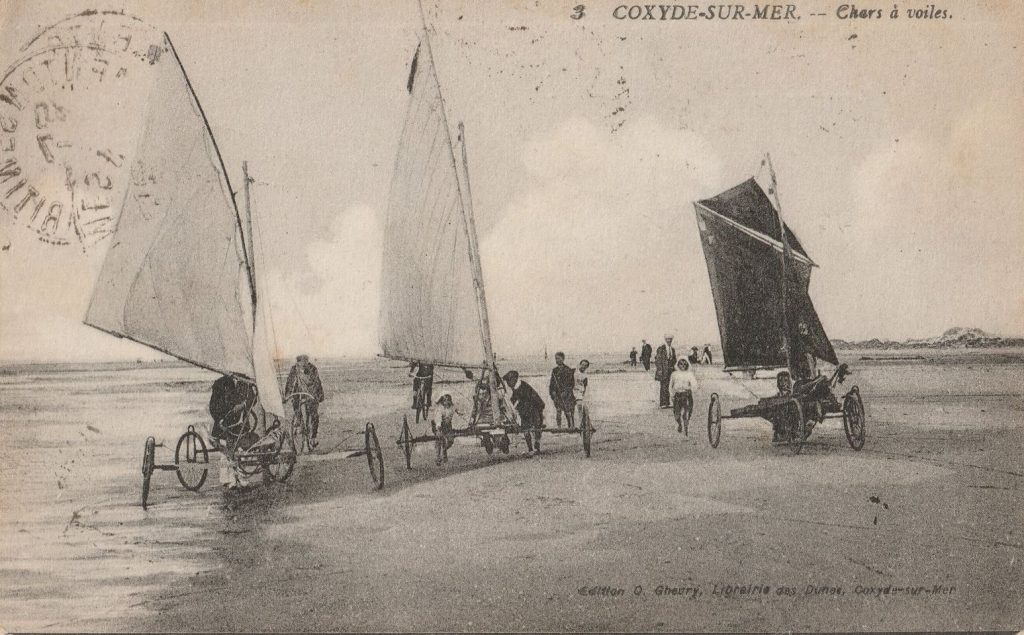Bob Teevan
Chariots with Sails
Koksijde (a modern spelling of the village name that appears on the card below) is a North Sea beach resort in West Flanders, Belgium. Almost within walking distance to the border with France, Koksijde is a favored site for beach goers and it was once the geo-center for a sport called sand sailing. The sport was also known as beach sailing and sand yachting. The caption on the card includes the term “chars à’ voiles” which loosely translated becomes “landslide” a word that has a much different definition in English but still easily understood as a sporting term. A better translation of chars à’ voiles would be “Chariots with Sails.” It is difficult to see a scene like this, with a title as such, without thinking of the 1981 film Chariots of Fire.

In addition to the “sailors” in the scene, others are people attending the three sand yachts and a few interested followers. The contraptions look fantastic with the two white sailed yachts being similar in size and style, and the dark sailed yacht to the right looking smaller and having a different combination of sails. The rider (I can’t think what other term to use as ‘yachtsman’ seems inappropriate) in the smaller sand yacht appears to be enjoying more success than the other two. The yacht on the left is almost in the sea while the middle one is perhaps being pushed along by children. There are cyclists in the background, and it may be the photographer has captured an action shot just after the start of an informal race.
The card is perforated down the left-hand edge which suggests that it has been removed from a souvenir book of cards relating to Coxyde-Sur-Mer. It may be that some collectors shun postcards removed from booklets; although why would it matter as long as the image is appealing?
Today Koksijde is still famous for beach sports although this is now known as “cyclo-cross.”
Chariots of Fire was set in the early 1920s, but this card predates the 1920s by about twenty years. The postmark on the card is indistinct although it may well be 1903. The stamp on the card was issued in 1903 and superseded by a subsequent issue in 1906 which provides a good indication of vintage.
This card was not mailed in Belgium but from the seaside town of Menton in the Apres-Maritimes district of France, some 780 miles from Koksijde. This explains why a Belgian postcard bears a French postage stamp.
The address and message are written in English and by the hand of a child. It is addressed to J. (Jack) Morris at the Hotel des Ambassadeurs, La Bourboule, Auvergne in France. If other postcard images of that hotel are to be believed, it was a large and impressive hotel.
Wikipedia advises – “It was built in 1858 but from 1866 it was extended and restructured. As a renowned hotel, it appears in the first tourist guides of the time. In 1890, it was one of the first to be equipped with an elevator and telephone. It then had a party room that could accommodate more than 500 people. In 1897, the rooms were equipped with heating (most hotels operating during the summer season were not so equipped).
“In 1900, M. Roubeau, the owner had electric lighting installed. During the First World War, it was [repurposed] as a military hospital. The hotel closed permanently in 1989 and was converted to private apartments in 1998.”
The parties associated with this card will remain mysteries, although the sender (M. White) is glad to hear that Jack has arrived safely and in addition to telling Jack that he “saw a large lizard” he advises that “we are building on 2 rooms to the cottage – 1 a bathroom,”
Although with many reservations, wouldn’t we love to pull back the years and learn what happened to Jack and M. White. The handwriting and dialogue provoke thoughts that these are well heeled boys of about 8 years of age and will soon be enjoying private education. Some 11 years later – at the outbreak of World War One – the boys would have been young men of 19 years of age. Being well educated and from monied families it is likely that sometime between 1914 and 1918 they would have come under peer, family, or social pressure to enlist as young officers.
Let’s just enjoy the freedom and innocence of this pre-war image and marvel at these ‘Chariots with Sails.’
The British Military Cemetery at Koksijde is the final resting place for many of the victims of the World War II Battle of Dunkirk.
Interesting. Thanks